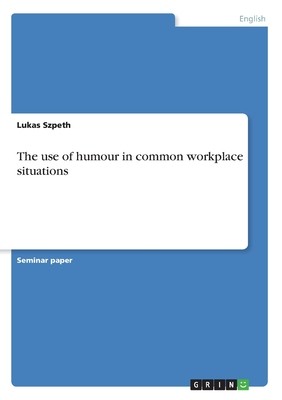
- We will send in 10–14 business days.
- Author: Lukas Szpeth
- Publisher: GRIN Verlag
- Year: 2020
- Pages: 28
- ISBN-10: 3346216268
- ISBN-13: 9783346216267
- Format: 14.8 x 21 x 0.2 cm, softcover
- Language: English
- SAVE -10% with code: EXTRA
Reviews
Description
Seminar paper from the year 2010 in the subject English Language and Literature Studies - Linguistics, grade: 2,0, University of Trier (Anglistik), course: The Pragmatics of Business Communication, language: English, abstract: This term paper will talk about the different characters or functions of humour with special consideration of workplace situations. This will be including the use of humour to create solidarity contrary to rivalrous humour and repressive vs subversive humour. It will become clear that humour is multifunctional and can work on different levels, which makes defining it difficult. Furthermore it tries to enlighten the linguistic strategies involved. Here the role of power will be looked at. The work shows what humour reveals about power relationships and its use either to enforce or to lessen status differences. The connection between the individual and a group can be defined through humour. How solidarity is achieved will be investigated. Afterwards, it is about the relation between humour and gender being followed by the strategy to create workplace harmony. The issue of how humour contributes to group life, the way it affects social relations will be another point of interest. Last but not least, it tries to show what kind of reactions can be evoked by using humour. It can work as tension releaser, as well as an aggression diffuser. Further possibilities of use are to hedge directives and to hide criticism which can trouble the participants. Especially the trouble of responding correctly to these will be an issue of discussion. The ambivalence of humour can be seen here again, which, once more, makes the problem of defining humour clear.
EXTRA 10 % discount with code: EXTRA
The promotion ends in 18d.19:27:19
The discount code is valid when purchasing from 10 €. Discounts do not stack.
- Author: Lukas Szpeth
- Publisher: GRIN Verlag
- Year: 2020
- Pages: 28
- ISBN-10: 3346216268
- ISBN-13: 9783346216267
- Format: 14.8 x 21 x 0.2 cm, softcover
- Language: English English
Seminar paper from the year 2010 in the subject English Language and Literature Studies - Linguistics, grade: 2,0, University of Trier (Anglistik), course: The Pragmatics of Business Communication, language: English, abstract: This term paper will talk about the different characters or functions of humour with special consideration of workplace situations. This will be including the use of humour to create solidarity contrary to rivalrous humour and repressive vs subversive humour. It will become clear that humour is multifunctional and can work on different levels, which makes defining it difficult. Furthermore it tries to enlighten the linguistic strategies involved. Here the role of power will be looked at. The work shows what humour reveals about power relationships and its use either to enforce or to lessen status differences. The connection between the individual and a group can be defined through humour. How solidarity is achieved will be investigated. Afterwards, it is about the relation between humour and gender being followed by the strategy to create workplace harmony. The issue of how humour contributes to group life, the way it affects social relations will be another point of interest. Last but not least, it tries to show what kind of reactions can be evoked by using humour. It can work as tension releaser, as well as an aggression diffuser. Further possibilities of use are to hedge directives and to hide criticism which can trouble the participants. Especially the trouble of responding correctly to these will be an issue of discussion. The ambivalence of humour can be seen here again, which, once more, makes the problem of defining humour clear.


Reviews